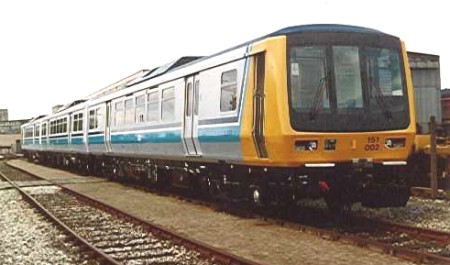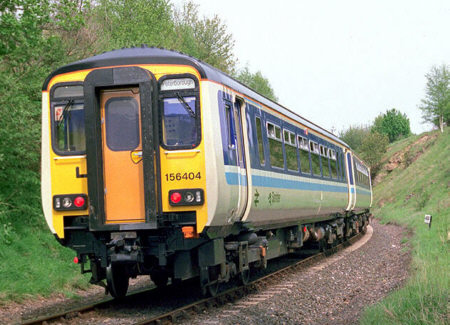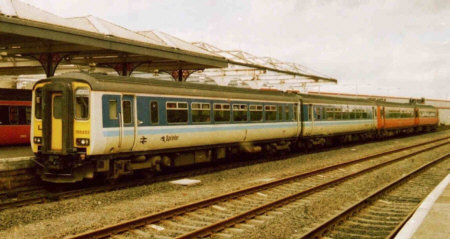Class Origins - 156 Super-Sprinter
156 » Class Origins • British Rail Years • Depot Allocations • Misformed Sets • Naming Details • Accidents • Time-Line
Class Origins - 156 Super-Sprinter |
|
156 » Class Origins • British Rail Years • Depot Allocations • Misformed Sets • Naming Details • Accidents • Time-Line | |
British Rail's Provincial Services sector, formed in 1982, was responsible for the unprofitable passenger services outside the Southeast of England.
The services were mostly operated by unreliable 1950's diesel-multiple units (DMUs), or, on the longer distance routes, locomotives and coaching stock - in some cases still steam heated. To compound these problems, much of the fleet had asbestos insulation, and British Rail had agreed to remove this by the end of 1987.
The Government had set tough targets for a reduction in annual subsidy, and Provincial had to drastically reduce it's operating costs to meet these.
It was decided that, as far as rolling stock was concerned, the way forward was to abandon the refurbishment and asbestos removal program and instead invest in a fleet of new DMUs. This included replacement of the loco-hauled trains.
Compared to a loco-hauled train, a modern DMU was cheaper to operate, caused less wear to the track and could reduce journey times.
Furthermore, rather than operate a loco-hauled train every two hours, the frequency could be increased to hourly using two-car trains.
Reversal, splitting and joining of trains en-route was also more practical.
Sprinters and Super Sprinters
Initially Provincial saw the need for two types of DMUs. Low cost light-weight railbus DMUs were seen as the solution for short distance and lightly used routes. For inter-urban routes, medium-weight DMU's of more traditional design would be used, and prototype 3-car units were ordered from BREL (class 150) and Metro-Cammell (class 151).
 |
The second of Metro-Cammell's class 151 Sprinters stands at the Railway Technical Centre, Derby, after delivery from Washwood Heath in June 1985. Photo: Dave Coxon |
Provincial marketed its new medium-weight DMU's as 'Sprinters', reflecting the improved acceleration and journey times when compared to it's existing trains. The railbus trains were marketed as 'Pacers'.
After the prototype Class 150 Sprinters entered service from late 1984 it became clear that these trains, which were derived from suburban electric-multiple units, would not be ideal for longer distance journeys of over an hour.
This became an important issue as Provincial developed a business strategy of increasing revenue on its core routes by enhancing services.
The initial builds of Sprinters, had been specified as 75 mph, 20 metre long vehicles featuring seating arranged with three and two seats either side of the aisle (3+2), but to create an ambience more comparable with locomotive hauled coaching stock, and perhaps more importantly the deregulated express coaches they were competing against, new units would have 2+2 seating with arm rests and tables. To maintain a high seating capacity they would need to be 23 metres long, the same as Mk.III carriage.
Provincial's new rolling stock was among the first to be procured under British Rail's new competitive tendering policy, but this process was complicated by the fact that not only was BREL a wholly owned subsidiary, but it's staff were also represented by the Nation Union of Railwaymen. The first trains from privately owned builders, the class 143 railbus, had been initially blacked by NUR guards.
Metro-Cammell had lost out to BREL on price for the first production batch of 50 Sprinters (Class 150/1) and determined to win business from BR after a gap of 20 years, sent out a message to its suppliers to cut prices if they were to break into this important market.
British Rail announced orders for it's 1986 and 1987 build programmes at the same time in November 1985. The 240 sprinter vehicles the Government had authorised for 1986 were split between BREL (85 20-metre two-car class 150/2) and Leyland Bus (70 23-metre Class 155). The order for the following years build of 228 vehicles (114 23-metre two-car class 156) was awarded to Metro-Cammell.
To differentiate the 23m units from the earlier types of sprinter, which had come in for criticism for their spartan interiors, the class 155 and 156 units came to be known as 'Super Sprinters'.
British Rail subsequently went on to order a higher specification Sprinter fitted with air-conditioning and with a 90 mph top speed. This became the class 158 'Express'.
BR's Provincial sector was re-launched as Regional Railways in December 1990, and the brand names 'Sprinter', 'Super Sprinter' and 'Express' became obsolete.
 | Brand new 156.404 in action during the Severn Valley Railway's Diesel Weekend, 7 May 1988. Photo: Steve Jones |
The class 156 DMUs were assembled at Washwood Heath, Birmingham, by Metro-Cammell. The first unit appeared in November 1987 and the 114th and last in September 1989.
Metro-Cammel's design for the Super Sprinter was completely different from it's class 151 prototype which had an aluminium body. Instead the class 156 would more resemble the trains that BREL was building.
Construction of the 228 welded steel bodyshells was sub-contracted out to wagon builders Procor Engineering (118), WH Davis (60) and Standard Wagon (50).
Fitting out of the interiors was subcontracted out to road-vehicle specialist Aston Martin Tickford.
Many of the components used were standard across the Sprinter fleet; Cummins engine, Voith transmission, Gmeinder final drive, BREL air-sprung bogies, Westinghouse brake equipment, Bergische Stahl Industrie 'Compact' automatic couplings.
BR also specified a cab layout which would now include an inter-unit gangway. Metro-Cammell had some difficulty with union acceptance of the Class 151 drivers cab, so for the Super Sprinters, the cab layout was based on that of the BREL class 150.
Exterior doors are of the single-leaf sliding pocket type, pneumatically powered. The door release and closing is controlled by the guard from a panel in the cab end vestibules. Controls for driver only operation were provided, but for a number of reasons these have not been used. Passenger door open and close buttons are provided at each door.
Both Super Sprinter classes featured a wheelchair accessible toilet in one vehicle, with power operated sliding door.

|
156.433 in 'Sprinter' livery, coupled to a unit in Strathclyde Transport livery arrives at Kilmarnock in 1990. Photo: John Hall |
The first 100 units were painted in Provincial's Sprinter livery, whilst the final 14 units were painted in Strathclyde Transport livery for use on PTE supported services around Glasgow.
Inside the trains, the side walls were painted cream, and the end walls and seat units were beige. The inner end of the passenger saloon had red diagonals either side of the doorway.
Seat covers were mid grey, with a bold red chevron pattern down the center. Floor carpets were a red and grey zig-zag pattern, and the area from below the window down to the heating duct was covered with grey cloth.